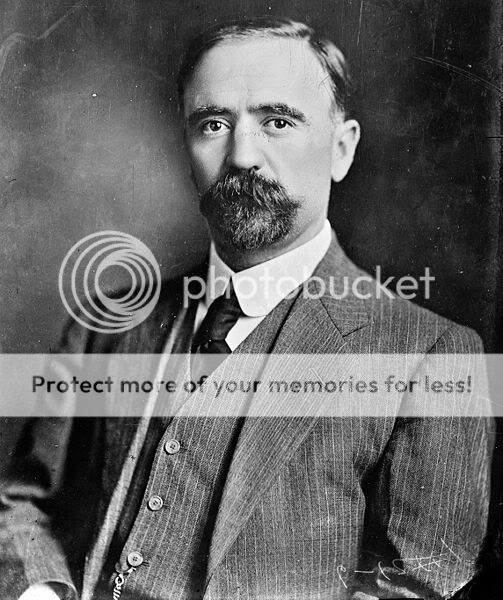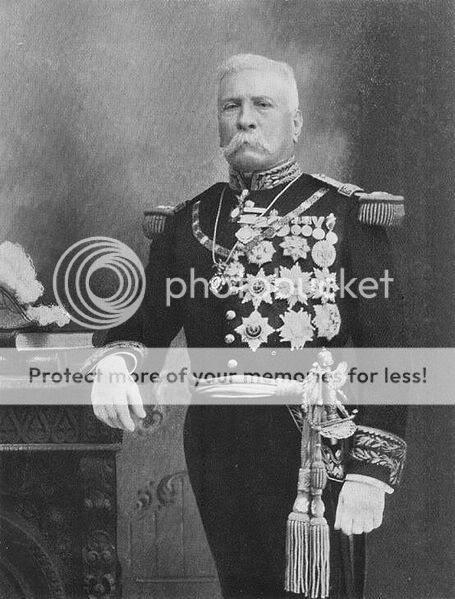1619 Prince Rupert of the Rhine, Royalist cavalry commander in the English Civil War, born. He returned England with the restoration of Charles II, and headed the investors group that in 1670 got a charter for the Hudson's Bay Company and title to all lands draining into Hudson Bay. He was the first Governor of the HBC.
1890 Union Pacific swithmen went on strike. Attribution: Wyoming State Historical Society.
1904 John J. McIntyre born in Dewey County, Oklahoma. He was the Congressman from Wyoming from 1941 to 1943, serving a single term. He served as State Auditor in 1946, and was later a Justice of the Wyoming Supreme Court from 1960 until his death in 1974.
McIntyre graduated from high school in Tulsa, Oklahoma and had a law degree from the University of Colorado at Boulder from 1929. He relocated to Wyoming in 1931 where he became the Converse County Attorney in 1933 and entered Federal service as an attorney in 1936. He was a member of the Wyoming National Guard and was promoted to the rank of Captain in1936. This was not unusual for lawyers of that period, as many held commissions on the Guard. He must have been in the Guard at the time it was Federalized in 1940, but his status as a Congressman likely took him out of service at the time of Pearl Harbor. He was not reelected to Congress and served as a Deputy Attorney General in 1943 and 1944, and then entered the U.S. Army as an enlisted man where he was a Staff Sergeant with the 660th Field Artillery.
1916 Inter Ocean destroyed by fire.
The Inter-Ocean
1916 Inter-Ocean Hotel in Cheyenne destroyed by fire. Attribution; Wyoming State Historical Society.
The Inter-Ocean was one of several Cheyenne hotels that were big deals
and major watering holes, something very common in that era and for
decades thereafter (and still somewhat true in larger cities today).
It's remembered to Western History for being the location referenced by
Tom Horn in his famous conversation with Joe LeFors.
If you go to the Inter-Ocean to sit down and talk a few minutes
some one comes in and says, 'Let us have a drink,' and before you know it
you are standing up talking, and my feet get so *&^*&^^ tired it
almost kills me. I am 44 years, 3 months, and 27 days old, and if I get killed
now I have the satisfaction of knowing I have lived about fifteen ordinary lives.
Horn was in fact arrested outside of the Inter-Ocean.
The hotel had been built by Barney Ford, a businessman who had been born
a slave, a status that he escaped from. His father was the white
plantation owners where his black mother was enslaved. After escaping
he lived an adventuresome life and rose to great wealth in Colorado.
He apparently liked the name "Inter-Ocean" as he built another hotel in
Denver's 16th Street by that name. Like the Cheyenne hotel, it is no
longer there, which is a real shame as funky buildings like this are all
the rage in Denver now..
Denver's Inter-Ocean
We've run a lot of newspaper articles on the negotiations between the
United States and Mexico, or perhaps more accurately between the United
States and the Constitutionalist government of Mexico lead by Venustiano
Carranza
Carranza
On this day he ended the doubt, he refused to sign it.
Carranza was a tough minded individual. He never liked Woodrow Wilson
and he had a grudge against the United States. Irrespective of what may
seem to be the advantages of the proposals that were made, he wouldn't
agree.
And he never did. Carranza never executed a protocol with the United States.
By this point the United States clearly wanted out of Mexico. The
intervention had bogged down to an uneasy occupation since the summer
and was going nowhere. Carranza guessed correctly that the United
States would be leaving no matter what, although that did not mean that
the US would be passive in protecting its interests.
1918 The USS Cheyenne, formerly the USS Wyoming, but renamed due the later battleship being assigned that name, assigned to Division I, American Patrol Division.
1918
December 17, 1918. No Booze for Soldiers. No Booze for Coloradans, No Booze for Montanans. Villa ponders attack
Up until at least the Korean War, if not the Vietnam War, a deficit of clothing meant that discharged soldiers often wore their uniforms after a time following their discharge. That was very much the case after World War One and World War Two. Here, the Federal Government was concerned about discharged soldiers drinking in uniform.
In the popular imagination, Prohibition was forced on an unwilling nation by a bunch of silly temperance women who didn't realize that America was a drinking nation. That version of the story is very far from true.
The Cheyenne State Leader was reporting that Montana would go dry on December 30. 1918 was to be Montana's last "wet" year. Villa, the paper also reported, was up to no good.
In reality, Prohibition was a hugely popular movement and was gaining ground in the states prior to it become Federal law. By this date in 1918, Colorado had gone "bone dry" and Montana was about to.
Not all was bleak. One of the Casper papers was reporting that American soldiers still preferred American girls. Those American soldiers would be bringing home quite a few French brides and even a few Russian ones. Of course, the report here did contain some bad news for American women. Some of the soldiers were reporting pretty favorably on les femmes Francais.
So Prohibition was really arriving in the individual states prior to the Volstead Act making it the law of the land and prior to any Constitutional amendment requiring it. When Prohibition was repealed, it meant that each state that had laws on the books had to revisit those laws if it wanted to likewise repeal Prohibition in their state, which serves as a lesson in rushing to amend laws to comport with what seems to be a national development. That allowed those states a breather to adapt to the new situation, which in the case of Wyoming it very much took, phasing drinking back in over a period of years.
1919
Vernon Baker born in Cheyenne. Baker is a recipient of the Congressional Medal of Honor for his actions in combat in World War Two, with his citation reading as follows:
For extraordinary heroism in action on 5 and 6 April 1945, near Viareggio, Italy.
Then Second Lieutenant Baker demonstrated outstanding courage and
leadership in destroying enemy installations, personnel, and equipment
during his company's attack against a strongly entrenched enemy in
mountainous terrain. When his company was stopped by the concentration
of fire from several machine gun emplacements, he crawled to one
position and destroyed it, killing three Germans. Continuing forward, he
attacked an enemy observation post and killed two occupants. With the
aid of one of his men, Lieutenant Baker attacked two more machine gun
nests, killing or wounding the four enemy soldiers occupying these
positions. He then covered the evacuation of the wounded personnel of
his company by occupying an exposed position and drawing the enemy's
fire. On the following night Lieutenant Baker voluntarily led a
battalion advance through enemy mine fields and heavy fire toward the
division objective. Second Lieutenant Baker's fighting spirit and daring
leadership were an inspiration to his men and exemplify the highest
traditions of the Armed Forces.
Baker had a rough start in life when his parents died while he was still young. Partially raised by his grandparents, he learned how to hunt from his grandfather in order to put meat on the table. Entering the Army during World War Two, he made the Army a career and retired in 1968 as a First Lieutenant, his rank at that time reflecting force reductions following World War Two. He retired to Idaho where he chose to live as he was an avid hunter, and he died there in 2010. Baker is a significant figure from Wyoming not only because he won the Congressional Medal of Honor, but because he was part of Wyoming's small African American community.
1985 Alan B. Johnson received his commission as a Federal Judge for the District of Wyoming.
2003 Wyoming filed a petition to delist the Prebbles Jumping Mouse from the Endangered Species List.



















































